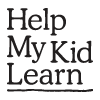Ages and Stages
Babies and children learn differently and reach the important stages of learning in different ways and at different times. In each age group we talk about some of the learning stages to look out for and how you can help your baby and your children to learn. We give possible ages when children reach certain stages of learning but often these ages don’t quite fit and the stages happen at other ages – earlier or later. So it’s important not to feel there is a problem if your friend’s child is doing things differently than your child.
From birth to 2 years
Your baby learns a huge amount during these years, perhaps the most they will ever learn in a 2-year period. Everything they learn at this time is important for their literacy and numeracy learning.
From birth to 6 months
In these early months babies listen and respond to sounds. They recognise voices. They like gentle singing and they learn from people talking to them.
Soon they start to make sounds back to you like cooing and gurgling. They play with their hands and their toes, with their tongue and their lips - with sucking sounds and blowing bubbles.
By about 6 months
They like you to count their fingers and toes and they like to play games like peek-a-boo. They begin to laugh and gurgle when you play these games.
Around this age they start making more sounds. This is called babbling and is important for language and talking. They also cry differently for different meanings, such as being hungry or tired.
By about one year old
They start to use gestures like waving and pointing to communicate.
They begin to respond to words: they might lift their arms when you say ‘up’ or towards you when you say their name. They are starting to recognise and understand words like shoes, hat, coat, dog.
They play with new sounds: ba, bo, mm, da-da and with sounds and rhythms like ‘all gone’.
They are picking up various objects, first big objects and then smaller items. Later, this stage of learning will help their writing.
By about 18 months
They may be starting to use words, though the words may not be clear. If you say the words back to them this will help them to get it right next time. They may say ‘bo-bo’ for bottle or ‘dan-dan’ for Grandad.
At this age many children will:
- pretend to speak into a toy phone.
- respond if you ask them to choose a book for you to read or look at with them. They like you to ask them to point to something in the picture: ‘Where’s the dog?’
- recognise songs and action rhymes and join in.
- copy actions like clapping.
They understand more than they can say. If you ask questions they respond and react, especially if you use their name: ‘Where’s John’s coat?’ ‘Where’s Ann’s teddy?’
They like you to count things with them and may start to copy the sound of the counting even if they don’t quite know what it means.
They might build a tower with blocks. You could count the blocks for them. Then they will knock it down!
By 2 years
They understand and try to use a lot of words now. They start to understand instructions like ‘Mammy’s turn’. They look around in response to questions such as, ‘Where’s Susie?’
Some children are putting 2 or 3 words together: ‘dog bark’; ‘John up’; ‘Granny go home’. Some children may start to use longer groups of words.
In some ways your child may seem to ‘go backwards’ in how they say words (for example ‘tar’ for ‘car’). This is because they are not just copying - they are now trying to find the right word for themselves and this is harder. It may still be difficult to understand what they are saying and they may find this frustrating because they know what they are trying to tell you!
They are starting to ask simple questions such as, ‘What that?’ ‘Who that?’
They like pretend play now and if you talk with them about what they are doing, they will respond. For example, if they are cuddling their teddy and you say “Ah you love teddy,” they might say “Shh, teddy sleeping”
